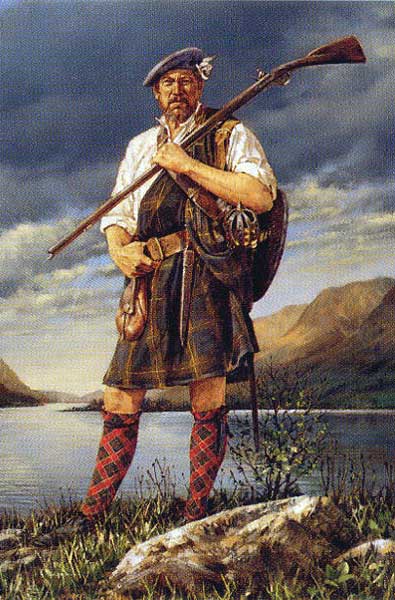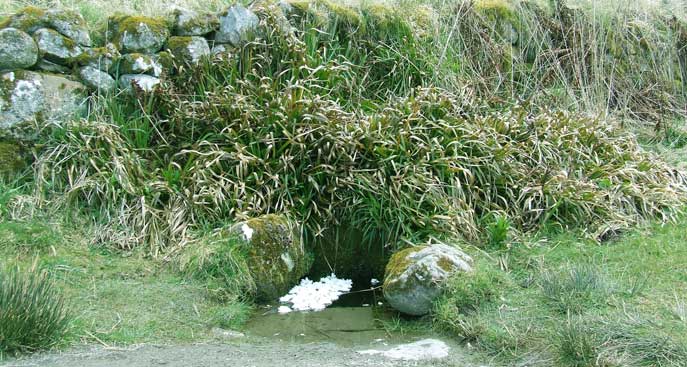THE JACOBITES |
 |
After James VII of Scotland was deposed, there were a series up uprisings aimed to restore the Stuarts to the throne of England and Scotland. James' throne had been usurped by his daughter Mary and her husband William of Orange. The war in Ireland was the initial conflict in James' attempts to regain the throne. That war inspired and encouraged risings in Scotland ('Bonnie Dundee'). It ended in October 1691, and the Irish army left for France to become the Irish Brigade, providing forces to later assist the 'Forty-Five' Jacobite Rising in Scotland. In 1689 'Bonnie Dundee' raised the Jacobite Standard on Dundee Law (a hilltop), and received support from 200 Irish troops arriving at Kintyre, and from Highand and Lowland Scots with Catholic and Episcopalian links (the Church of Scotland was aligned to the English powers). At a time when infantry were trained to fight in formation, the Highlander's method was to set aside their plaids and other encumbrances before the battle, drop to the ground if their enemy fired a volley then, after quickly returning fire, run screaming at their foe in the Highland charge with broadsword and targe (shield) or whatever other weapon they had, sometimes pitchforks or Lochaber axes (a combined axe and spear on a long pole). This charge could be devastating to troops in formation still struggling to fix their 'plug' bayonets which were inserted in the barrel of their muskets. This charge worked at the battle of Killiecrankie in 1689. |
Haughs of Cromdale in 1690, and Mackay constructed Fort William as a new defence. In June 1690 the jacobites learned of William's victory over James at the Battle of the Boyne. Jacobite hopes were dashed. A year later they were forced to agree to a truce while the Clan chieftains sent requests to the exiled James for permission to submit to William. In January 1692 the Jacobite Clans formally surrendered to the government. James raised a French army of 6000 men and 30 ships and sailed from Dunkirk in 1708, but was engaged by the English navy on their way to the Firth of Forth and driven back to France. Following the Act of Union in 1707, and the arrival of George of Hanover in 1714 (see left), discontent with the new establishment led to the first Jacobite Rising in 1715. The Earl of Mar, at the behest of James, went to Braemar and summoned clan leaders to a grand hunting-match on August 27, 1715. By September 6th they had proclaimed James as their lawful sovereign and raised the old Scottish standard. This encouraged an alliance of both Highland and Lowland clans who detested the Whig repression which characterised the Union. They captured Perth the following month, but planned risings in Devon and Wales were stopped by Government troops. A force left Perth for Edinburgh but were repelled by Argyll's forces after an initial victory in capturing Leith Citadel. Mar's forces met with Argyll's again at Perth in November but failed to show strength. James arrived at Peterhead in December and briefly set up court at Scone, then beat retreat to France in January because of lack of numbers in the assembled troops. In 1725 Wade raised the independent companies of the Black Watch as a militia to keep peace in the unruly Highlands, but in 1743 they were moved to fight the French in Flanders, setting the scene for another Jacobite attempt. |
 |
The War of the Austrian Succession drew Britain and France into open hostility in 1743. It was to be a surprise attack with troops marching from their winter quarters to hidden invasion barges which were to take them and Charles Edward Stuart (later known as Bonnie Prince Charlie or the Young Pretender - see left) to Maldon in Essex where they were to be joined by local Tories in an immediate march on London. One of the worst storms of the century scattered the French fleets which were about to battle for control of the English Channel, sinking one ship and putting five out of action. The barges had began embarking some 10,000 troops and the storm wrecked the troop and equipment transports, sinking some with the loss of all hands. Charles was officially informed on February 28 that the invasion had been cancelled. Charles did not give up hope (yet). In collusion with some privateers from Nantes who were funded by exiled Scots bankers, they fitted out a small Frigate and a ship of the line (the Elisabeth) and set out for Scotland in July 1745. The Elisabeth, carrying weapons, supplies and 700 volunteers from the Irish Brigade, encountered the British Navy ship HMS Lion and with both ships badly damaged in the ensuing battle the Elisabeth was forced back, but the Frigate successfully landed Charles with his seven men of Moidart on the island of Eriskay in the Outer Hebrides on August 2nd 1745. The Scottish clans and their chieftains showed little enthusiasm since he had no troops or munitions, but Charles went on to Moidart and on August 19th 1745 raised the standard at Glenfinnan to lead the Second Jacobite Rising in his father's name. This attracted about 1,200 men from Clan MacDonald of Clanranald, Clan MacDonell of Glengarry, Clan MacDonnell of Keppoch, and Clan Cameron. They marched south from Glenfinnan, increasing to almost 3,000 men. In response, almost 60 clans provided men to swell the ranks further. Most of the british Army were in Flanders and Germany, with only a small force left in Scotland. King George II was not popular, and so they found little support locally. There was panic in Edinburgh, and the City Guard and Volunteers fled. When the city gate at the Netherbar Port was opened to let a coach pass, the Camerons rushed in and seized control of the Capital. The next day King James VIII was proclaimed at the Mercat Cross and Charles entered Holyrood palace in triumph. |
 |
In September Lord George Murray and his men routed the government forces at Prestonpans. Meanwhile, Charles held court at Holyrood for five weeks, and the French sent some weapons and funds. All should have been well, but Charles failed to really generate much further support locally, and many highlanders headed home. A Jacobite army of 6,00 men eventually set out for England, but in the interim the British Army had sent a significant force back to meet them under General George Wade. The Jacobite forces avoided Wade's men at Newcastle, and marched on Derby (125 miles from London !). However, despite such success, all was not well. The promised French and English support did not materialised. Wade and Cumberland were now approaching. A militia was forming in London. On December 6th the Jacobites began their retreat. The French received news of the retreat and so cancelled their now-ready invasion. By Christmas the Jacobites forced the city of Glasgow to re-provision them. They left to seize the town of Stirling in January, and on January 17th around 8,000 Jacobites approached General Henry Hawley at the Battle of Falkirk and routed his forces. They turned north and took Fort Augustus and Fort George in Inverness by early April. On April 16th 1746 they were finally defeated near Inverness at the Battle of Culloden by Hanoverian forces under the command of the Duke of Cumberland. Charles fled to France making a dramatic escape disguised as a 'lady's maid' to Flora Macdonald. |
 |
Jacobite Timeline |
Feb 6 1685 Charles II of England died and was succeeded by his brother, James II, a Roman Catholic. Charles II became a Roman Catholic on his deathbed. |
 |
© Paisley Tartan Army 2008-09
